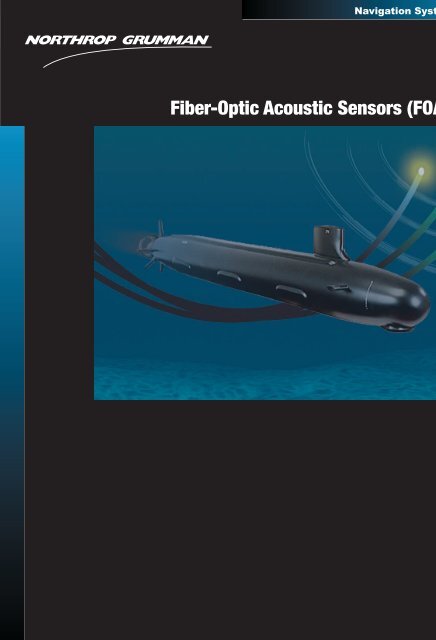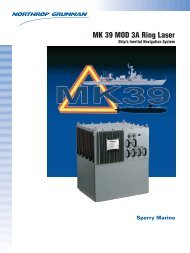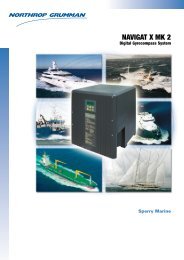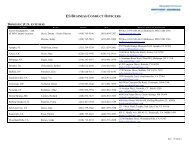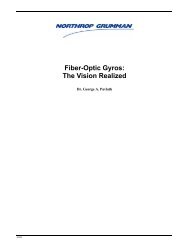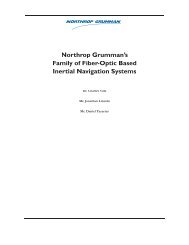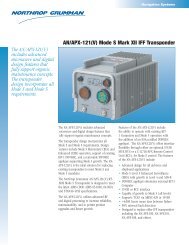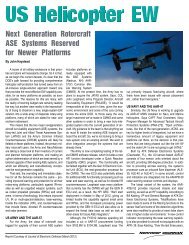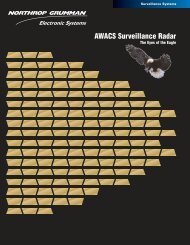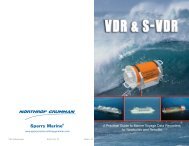Fiber-Optic Acoustic Sensors (FOAS) - Northrop Grumman ...
Fiber-Optic Acoustic Sensors (FOAS) - Northrop Grumman ...
Fiber-Optic Acoustic Sensors (FOAS) - Northrop Grumman ...
You also want an ePaper? Increase the reach of your titles
YUMPU automatically turns print PDFs into web optimized ePapers that Google loves.
Navigation Systems<br />
<strong>Fiber</strong>-<strong>Optic</strong> <strong>Acoustic</strong> <strong>Sensors</strong> (<strong>FOAS</strong>)
<strong>Northrop</strong> <strong>Grumman</strong> Corporation’s Navigation<br />
Systems Division has applied its expertise in fi beroptic<br />
technology to develop a line of acoustic sensors it<br />
calls <strong>Fiber</strong>-<strong>Optic</strong> <strong>Acoustic</strong> <strong>Sensors</strong> (<strong>FOAS</strong>). <strong>FOAS</strong> origi-<br />
nated in 1981 as part of a major effort to develop both<br />
fi ber-optic gyroscope and fi ber-optic hydrophone sensor<br />
technologies. This effort, which has required investment<br />
of over $140 million, has established <strong>Northrop</strong> <strong>Grumman</strong><br />
as the world’s leader in optical acoustic sensor technolo-<br />
gy and exclusive manufacturer of Department of Defense<br />
fi ber-optic acoustic sensor array systems.
<strong>FOAS</strong> Description and Capabilities<br />
<strong>Northrop</strong> <strong>Grumman</strong> can produce fi ber-<br />
optic acoustic sensor arrays for a variety of<br />
applications. <strong>Northrop</strong> <strong>Grumman</strong> builds<br />
three <strong>FOAS</strong> systems: hull arrays like the<br />
Light Weight Wide Aperture Array<br />
(LWWAA) currently on USS Virginia-Class<br />
Submarines, towed arrays for submarine<br />
and other applications, and fi xed bottom<br />
arrays for deep ocean and shallow/littoral<br />
water surveillance.<br />
The arrays themselves comprise only pas-<br />
sive fi ber-optic elements, and contain very<br />
few parts and no electronics. One remote<br />
transmit/receive station houses all the nec-<br />
essary optoelectronics. The data are trans-<br />
mitted on a few single mode fi bers, over<br />
distances of more than 100 kilometers.<br />
Over the past 15 years, <strong>Northrop</strong> Grum-<br />
man and the U.S. Navy have made signifi -<br />
cant strides in developing fi ber-optic sensor<br />
Basic Principle of <strong>FOAS</strong> Operation<br />
<strong>FOAS</strong> sensors use standard interferometer<br />
principles to detect acoustic<br />
energy. <strong>Optic</strong> fi ber is wrapped tightly<br />
around malleable plastic spools called<br />
mandrels. As pressure from the acoustic<br />
event moves across the sensor mandrel, it<br />
changes shape causing the optical fi ber to<br />
stretch or relax.<br />
When light is projected through the<br />
optical fi ber wrapped around the sensor<br />
mandrel, the acoustic energy deforms the<br />
mandrel and changes the distance the light<br />
has to travel. This is compared to the dis-<br />
tance light travels through the optical fi ber<br />
on a reference mandrel. The optical phase<br />
difference between the two, representing<br />
the acoustic energy, can easily be mea-<br />
sured and passed on to the signal process-<br />
ing equipment.<br />
technology for passive acoustic monitoring.<br />
This work has focused on demonstrating<br />
the advantages of fi ber-optics over conven-<br />
tional piezoceramic sensor arrays.<br />
One of the primary advantages of fi ber-<br />
optic acoustic arrays is their simplicity.<br />
Ceramic acoustic arrays require power,<br />
complex electronics and signal processing<br />
to be located close to the sensor to over-<br />
come resistance losses.<br />
Ceramic arrays also have numerous con-<br />
nectors and mechanical joints that reduce<br />
their reliability. The electronic processing<br />
elements of a fi ber-optic array are located<br />
in a dry or controlled environment on a<br />
submarine or on shore. Their location al-<br />
lows them to be accessed for maintenance<br />
purposes and technological refresh, which<br />
is not possible with legacy ceramic arrays.
Legacy<br />
Ceramic Array<br />
Power In<br />
Multiplex<br />
and <strong>Optic</strong>al<br />
Conversion<br />
A/D<br />
Conv.<br />
Sensor<br />
Signal<br />
Cond./<br />
Filters<br />
∆V∆P<br />
Preamp<br />
Hundreds of active electronic and optical components, joints,<br />
connectors and interfaces required for each channel<br />
Light Weight Wide Aperture Array on<br />
Virginia Class Submarines<br />
The Navy’s newest Virginia-class subma-<br />
rines employ a Light Weight Wide Aperture<br />
Array (LWWAA) on its hull for advanced<br />
acoustic detection. The LWWAA system is<br />
a set of large array panels that are mounted<br />
on either side of the submarine, which<br />
provide sonar sensor input to the subma-<br />
rine’s combat system. Instead of traditional<br />
ceramic hydrophone sensors, the<br />
LWWAA uses <strong>FOAS</strong> technologies to con-<br />
vert a target submarine’s acoustic energy in<br />
the water into information that can be used<br />
to identify and track it. <strong>Northrop</strong> <strong>Grumman</strong><br />
designed, developed and manufactures the<br />
key optical sensing elements of this<br />
<strong>FOAS</strong> array.<br />
Towed Arrays<br />
<strong>Northrop</strong> <strong>Grumman</strong> has designed and<br />
developed high channel count fi ber optic<br />
towed arrays for submarine applications.<br />
The performance of these arrays has been<br />
Clock<br />
Synchro<br />
<strong>Acoustic</strong> Event ∆P<br />
λ0<br />
superior to equivalent ceramic arrays and<br />
its ruggedness and reliability have been ex-<br />
ceptional. It is expected that future towed<br />
array systems will transition to fi ber-optic<br />
technology to take advantage of the lower<br />
cost, reliability and ruggedness.<br />
Surveillance Systems<br />
The U.S. Navy and <strong>Northrop</strong> <strong>Grumman</strong><br />
continue to be actively involved in the de-<br />
velopment of all fi ber-optic acoustic sensor<br />
surveillance arrays for anti-submarine war-<br />
fare passive sonar. They may be deployed<br />
in all types of terrain and marine environ-<br />
ments to accommodate such applications<br />
as perimeter security, harbor monitoring,<br />
and ground surveillance. Depending on<br />
the application, these arrays may contain<br />
optical geophones, fi ber-optic hydro-<br />
phones, and/or fi ber-optic microphones.<br />
The Centurion Harbor Surveillance pro-<br />
gram demonstrates our <strong>FOAS</strong> capabilities<br />
in this area.<br />
<strong>Fiber</strong>-<strong>Optic</strong> Array<br />
λ +∆Φ<br />
0<br />
∆Φ/∆P<br />
<strong>Optic</strong>al Interrogation Analog <strong>Optic</strong>al Output<br />
Less than 10 passive components and splices per channel<br />
Other advantages of fi ber-<br />
optic arrays over convention-<br />
al arrays include:<br />
• Lower power requirements<br />
• Increased reliability due to a<br />
simplifi ed array design<br />
• Reduced maintenance costs<br />
• Lower cost to manufacture<br />
• No underwater electrical compo-<br />
nents or wires<br />
• Light weight and small cable<br />
diameter, which facilitate rapid de-<br />
ployment and recovery of the array<br />
• Immunity to electromagnetic<br />
interference (EMI)<br />
• Immunity to high radiation<br />
• Diffi cult to detect since the fi ber-<br />
optic sensor array is not operated<br />
electrically and consists of only<br />
non-metallic materials.
����������<br />
����������������������������<br />
�����������������������������<br />
�����������������������������<br />
���������������<br />
���������������������<br />
���������������������������������<br />
Centurion Harbor Surveillance<br />
Program for Homeland Security<br />
Applications<br />
<strong>Northrop</strong> <strong>Grumman</strong>’s <strong>FOAS</strong> technology<br />
is a key element in the Centurion Port-<br />
Harbor Anti-Terrorism/Force Protection<br />
system which provides the operator with<br />
a complete status of the harbor he<br />
is monitoring.<br />
This integrated sensor and display product<br />
shows the harbor vicinity and potential<br />
threats on a standard Navy display system<br />
located at the test site. During a demon-<br />
stration, divers with a battery-powered<br />
underwater propulsion device were easily<br />
detected attempting to penetrate the har-<br />
bor. Surface craft traveling in the test area,<br />
and entering the restricted Port of Huen-<br />
eme, were also detected and tracked.<br />
The proof-of-concept demonstration was<br />
completed within three months of the<br />
contract award by the U.S. Navy’s Mari-<br />
time Surveillance Systems Program Offi ce,<br />
utilizing passive fi ber-optic sonar arrays<br />
and support equipment delivered by<br />
<strong>Northrop</strong> <strong>Grumman</strong>’s Navigation Systems<br />
Division, coupled with commercial-off-<br />
the-shelf equipment provided by <strong>Northrop</strong><br />
<strong>Grumman</strong>’s Sperry Marine business unit in<br />
Charlottesville, Virginia.<br />
The equipment provided by Sperry Marine<br />
included the marine radar, Automatic<br />
Identifi cation System (AIS) shipboard iden-<br />
tifi cation system and the digital electronic<br />
charting system that provided the com-<br />
mon integrated harbor picture.<br />
The <strong>Northrop</strong> <strong>Grumman</strong> team completed<br />
a threat analysis for the port and deter-<br />
���������������������<br />
������������������������<br />
�����������������������������<br />
�������<br />
mined the most effective locations to place<br />
the underwater arrays. The array installation<br />
was performed with the assistance of the Na-<br />
val Facilities Engineering Support Center and<br />
the team’s ocean engineering subcontractor,<br />
Sound and Sea Technology, Inc. of Edmonds,<br />
Washington and Ventura, California.<br />
Performance benefi ts of this technology<br />
include unsurpassed detection, identifi ca-<br />
tion and tracking capability for the harbor<br />
defense applications. Since no electronic<br />
components are in the water, the fi ber-optic<br />
arrays provide a highly reliable solution that<br />
also offers reduced acquisition and mainte-<br />
nance costs. The arrays employ glass fi bers,<br />
instead of older technology piezoelectric<br />
hydrophones, to convert sound to modulated<br />
light for effi cient transmission to shore.
<strong>Northrop</strong> <strong>Grumman</strong><br />
Navigation Systems Division<br />
21240 Burbank Boulevard<br />
Woodland Hills, California 91367 USA<br />
1-866-NGNAVSYS (646-2879)<br />
www.nsd.es.northropgrumman.com<br />
24040 <strong>FOAS</strong> Overview/01-07/2000/Crawford


